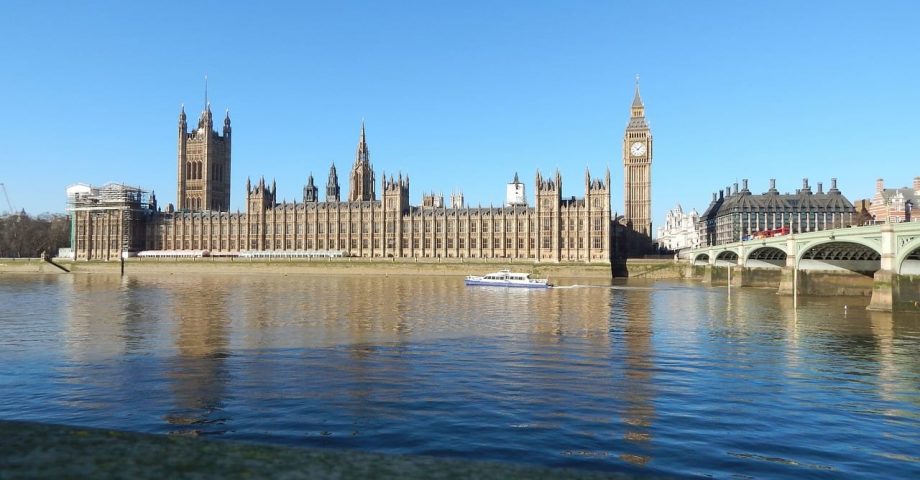When it comes to lawmaking and some of the most important societal matters affecting the UK, you can always look toward the Houses of Parliament.
The Houses of Parliament are where the main representatives of the British government sit. It is here that laws are discussed, changed, and made, and MPs debate matters that affect the running of the country. It’s where politicians should be taking the time to represent their constituents!
Some of the most dramatic and history-changing moments occurred either in the House of Lords or the House of Commons, and it’s safe to say tradition will keep the meetings and law-makings here running for many years to come. Here are a few interesting facts about the Houses of Parliament which might surprise you.
1. It’s been an institution for hundreds of years.
The Houses of Parliament date back centuries, specifically to the 1200s. In typical British fashion, elements of the Houses still date back to medieval times, making both the Lords and the Commons genuine relics.
However, the houses were rebuilt over the years, with fires destroying almost all of the buildings in the 19th century.
2. The King holds a lot of power over parliament.
While the reigning British monarch may not have as much of a say in lawmaking beyond royal assent these days, the King is still technically the one true owner of the Houses of Parliament.
This is due to the UK’s interesting status as a constitutional monarchy. This means that the King may also use it as a place of residence. Of course, he is also crucial to the re-opening of Parliament once a year.
In fact, interestingly, the Houses of Parliament building is formally known as The Palace of Westminster, which is definitely a far more regal name!
3. It’s more than just political business in here.
The Houses of Parliament exist to offer more than just political and legal discussions. There are rooms such as the extensive Royal Gallery which are used to host important dinners and galas. It was even used as a courthouse of sorts for a time.
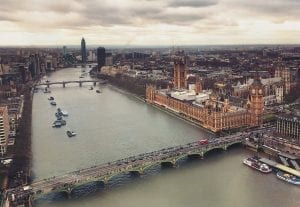
4. Big Ben overlooks the Houses.
You’ll likely have noted that the Houses of Parliament has a pretty impressive clock – that’s Big Ben. This is perhaps the most famous landmark in London, and Big Ben actually refers to the bell in the tower – it’s now called Elizabeth Tower.
However, it was only named Elizabeth Tower in 2012 in honour of Queen Elizabeth II’s Diamond Jubilee. Before then, it was simply known as the Clock Tower.
5. Colours have meaning here!
There is an interesting colour coding system within the Houses of Parliament. If you ever tour them, you will find that gold colours signify elements used by monarchs, green for Commons attendants, and red for the House of Lords.
6. Parliament is sovereign.
Both Houses have their place in terms of important law-making and decision-making. It is always widely stated that “parliament is sovereign,” which means that any decisions made within parliament must be adhered to at all times in law, which also means that any court in the country must abide by decisions made here.
Parliament law is final! This is particularly interesting, as, unlike the US, there is no physical constitution in the UK.
7. The Commons Speaker plays an important role during debates.
There is a role within the House of Commons known as the Speaker. The Speaker’s role is to try and keep the debate in order. This can sometimes be difficult as there are often wide-ranging discussions over very difficult and complex topics!
What’s more, MPs aren’t always destined to get on with each other, let alone see each other’s points of view!
The Speaker performs their duties from the Speaker’s Chair, at the end of the room, perfectly situated between the opposing sides to signify their impartial duties to maintain order within the house.
8. There’s a strange dress code that you’re unlikely to break.
There’s an odd law in place within the Houses of Parliament which still stands to this day. Specifically, you aren’t allowed – by law – to wear a suit of armor during any visit. Oddly specific, but we’re sure most people will do their best to abide by this regulation!
9. People get appointed to join the Lords.
The House of Lords consists of Lords who have peerages, which are generally appointed. There are two types of Lords, Temporal and Spiritual.
Most Lords are Temporal – these are those who are appointed and who are hereditary – while Spiritual Lords are those who are bishops and archbishops. Therefore, the Church still has a place in British lawmaking.
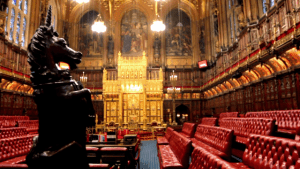
10. WWII took its toll on parliament.
The Houses of Parliament suffered greatly during the Second World War. The Palace of Westminster, in particular, suffered at least 14 direct hits during the Blitz, which led to significant work taking place to bring it back to full character.
The House of Commons, meanwhile, almost fell completely, and had to undergo a complete redesign.
11. The King opens up parliament each year.
The opening of parliament is accompanied by the King’s Speech. Unlike his Christmas TV broadcast, this speech is actually written by the standing government.
Despite belief to the contrary, the monarch has no power over this speech, and they cannot change it at all before reading it out.
12. It is a central part of the city.
The Houses of Parliament, also known as the Palace of Westminster, are situated in the City of Westminster in central London, on the north bank of the River Thames.
If you happen to have any trouble finding it, just look across the river from the London Eye; they’re right opposite each other!
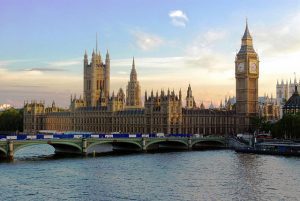
13. It all began with King Canute.
In the early 11th century, King Canute began the construction of a royal residence in London. That residence was where the Houses of Parliament now stand. Therefore, the Houses have been a royal palace for thousands of years!
14. It all came burning down.
As mentioned above, tragically, the Houses of Parliament have had to be rebuilt on multiple occasions. One reason they needed rebuilding was due to the Fire of 1834. Most of the medieval structures were destroyed by fire.
However, the reconstruction brought much of the architecture still in the building today.
15. Reconstruction took decades.
The palace reconstruction started in 1840 and was mostly finished a few decades later, in 1870. Architects Sir Charles Barry and Augustus Pugin designed much of the Gothic architecture style.
Augustus Pugin’s design work includes intricate interiors, furnishings, and important details such as the royal thrones and the famous “Pugin wallpaper.”
Big Ben was also brought to the palace during reconstruction. The Elizabeth Tower, as it later became known, was officially completed in 1859.
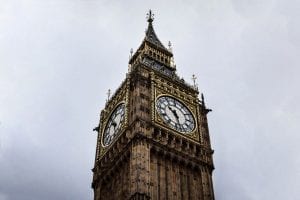
16. The House of Commons proposes laws.
There is no denying that the Houses of Parliament can be pretty confusing, even for Brits! But, a simple way of putting it is that the House of Commons, also known as the lower house of Parliament, is responsible for making and passing laws, making decisions about money, and even voting to make the prime minister call an election or even resign. The House of Commons also has a fixed number of seats.
17. The House of Lords judges the laws the Commons put forward.
On the other hand, the House of Lords, also known as the Upper House of Parliament, reviews and revises proposed legislation and is composed of life, bishops, and hereditary peers.
At last check, there are currently 92 hereditary peers sitting in the House of Lords (and that number has already been greatly reduced,) and 26 bishops. The House of Lords has no fixed number of seats.
There’s a final way of differentiating the two is by their seats! The benches in the House of Commons are green, while the benches in the House of Lords are red. It is a tradition dating back centuries.
17. There are other towers beyond Big Ben’s.
Although most of us tend to pay more attention to the Elizabeth Tower and its magnificent Big Ben, the palace actually holds two other towers.
For example, the Victoria Tower, which was completed in 1860 and is on the other side of the palace, is the tallest tower in the palace, standing at an impressive 98.5 metres high. It houses the Parliamentary Archives.
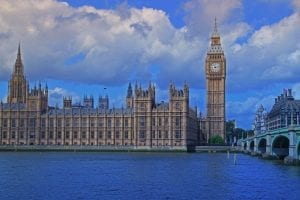
18. Westminster Hall holds a lot of history.
Currently, Westminster Hall is the oldest part of the Palace of Westminster, and it is still in existence. It was built in 1097 and is famous for its vast, unsupported roof. It was originally built for William II and, at the time, was the biggest Hall in Europe.
19. You can visit the Palace as a tourist!
Yes – you can absolutely visit the Houses of Parliament! Tours are open to the public and provide fascinating insights into the UK’s legislative process and historical heritage.
For a guided tour, each adult must pay £35 on the day, or they can book their ticket online beforehand for £33. Be sure to exchange your money if you’re visiting from abroad.
If you are fortunate, you may even be able to see a debate or a big moment for the country! Both the House of Commons and the House of Lords have public galleries where visitors can watch debates and proceedings.
20. Big Ben isn’t the only bell.
Big Ben shouldn’t take all the glory – as there is also the Division Bell. When rung, the Division Bell lets MPs (Members of Parliament) know when a vote, also known as a division, is about to take place.
21. The palace is also made up of lobbies.
The Palace of Westminster also famously has two main lobbies. These are known as the Members’ Lobby and the Peers’ Lobby. The lobbies are where MPs and Lords can meet and discuss matters informally.
Then there is the Central Lobby, which can be found at the centre of the palace. It is a hall that serves as the meeting point between the Commons and the Lords.
22. Order is maintained by the Black Rod.
The Gentleman Usher of the Black Rod is a designated and senior officer in the House of Lords. It’s their job to help keep order in the Lords – as frantic a job as that can be at times!
Interestingly, the position is currently held by Sarah Clarke. She is the first female Black Rod ever in the 650 years that the Black Rod position has been around!
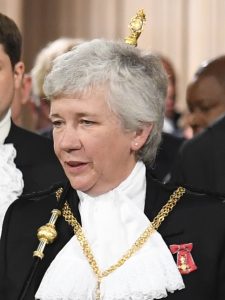
23. The Ceremonial Mace must be held in the House of Commons at all times.
The House of Commons has a ceremonial mace in the centre of the room. The mace represents the monarch’s authority and must be present for the House to meet and pass laws.
The one currently sitting in the House of Commons is the fourth replica to sit there, at the time of writing.
24. Everything is noted down in the Hansard.
All official parliamentary debates are recorded in Hansard. The Hansard holds the official verbatim report of proceedings. It was named after the 19th-century printer Thomas Curson Hansard.
Nowadays, the Hansard is available online and available to the public. The Hansards are published on the interest every morning following the previous sitting day.
25. The flags will tell you everything you need to know.
When the Union Flag is flying above Victoria Tower, Parliament is in session.
On the other hand, when the Royal Standard is flying, this means that the monarch is present in the Houses of Parliament. The King uses a similar flag system at Buckingham Palace to show when he’s in residence (and when he isn’t!).
26. It is extremely well-protected.
As you can imagine, security at the Houses of Parliament is a very serious matter! In fact, the palace has its own dedicated police force known as the Parliamentary Security Department. This force is responsible for the protection of the palace and all of those within it.
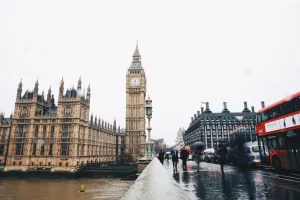
27. The Prime Minister has to answer questions regularly.
Every week on Wednesday, the Prime Minister must attend the PMQs, also known as the Prime Minister’s Questions. It is a particular session during which MPs get to ask the Prime Minister questions directly, which they must answer to the best of their capabilities.
28. It is a UNESCO World Heritage Site.
The Palace of Westminster, Westminster Abbey, and St. Margaret’s Church were designated UNESCO World Heritage Sites in 1987, recognizing their cultural and historical significance.
29. There are many different staircases across the building.
As an old set of buildings developed long before the rise of accessibility, both the House of Commons and the House of Lords are famous for their many long and narrow staircases.
Believe it or not, there’s said to be more than 100 different staircases across the whole of the Houses of Parliament – and they’re completely necessary to get to various viewing galleries and other important spots.
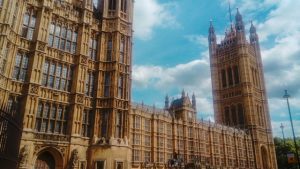
30. Animals are almost completely banned from parliament.
Insert a tongue-in-cheek joke about politicians behaving like animals here! Jokes aside, animals are virtually forbidden from attending the Houses of Parliament, largely because it is such a protected space.
However, there’s one exception – service dogs, such as guide dogs for blind or hard-of-seeing people, are permitted to enter with the correct paperwork.
31. It’s probably easy to get lost in here.
The Houses of Parliament are truly massive – there’s said to be at least 1,000 different rooms with all kinds of purposes – meaning unless you’re an MP or Lord who really knows their way around, you’d probably be forgiven for getting a bit lost sometimes!
Be sure to ask for a guide if you’re visiting as a tourist – there’s always likely to be someone on hand who can help!
FAQs about The Houses of Parliament
How many houses are there in Parliament?
There are officially two main houses in Parliament, though it’s split into three different parts. As mentioned above, there is the House of Lords and the House of Commons. The three parts include both houses and the sovereign, of course.
Who built the Houses of Parliament?
Parliament’s houses were built towards the end of the 11th century by King William II - but it’s been remodelled several times since then.
However, before him, King Canute began building where the Houses of Parliament now stand, although he was building his own royal residence as opposed to a place for parliament!
How many rooms are there in the Houses of Parliament?
There are thought to be more than 1,000 different rooms across the entirety of the Houses of Parliament! There are also 100 staircases and nearly 5km of passageways across the building!
Do you know any fun facts about the Houses of Parliament? Share them in the comments below!
Further reading:
https://www.parliament.uk/
https://www.visitlondon.com/things-to-do/place/401836-houses-of-parliament
